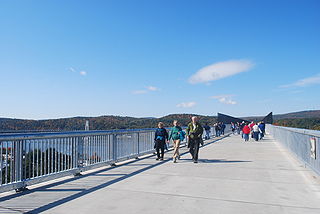Governor Andrew Cuomo may have axed plans ten years in the making to build transit across the Tappan Zee Bridge, but hey, at least he promised to consider turning the old structure into a park, right?

During a cabinet meeting Wednesday, Cuomo promised to study turning the current Tappan Zee Bridge into a walkway across the Hudson instead of demolishing it when a new bridge is completed. If the governor's support for the walkway concept is intended to greenwash his bloated, automobile-only bridge, it's working.
The governor's promise just to study the idea got the New York Times to finally turn its attention to the bridge. A story in yesterday's edition marks only the third time the paper of record has discussed the governor's plans to rebuild the bridge since the project was stripped of its transit components and fast-tracked through the review process last October. The first Times article focused on the expedited review process, the second on the vision of a High Line-esque walkway.
In contrast, the New York Times has at no point reported on the fact that there's still no plan to pay for the new bridge, that it would be twice as wide as the current span, or that the administration has slammed the door on the public outreach process. Cuomo's decision to kill transit on the bridge got four he-said, she-said paragraphs tacked on to the end of yesterday's article and no mention at all in the previous story.
At least the Westchester Journal News, which today ran an editorial endorsing the Tappan Zee greenway ideal, has done more consistent and rigorous reporting on the plans for the bridge than any other outlet.
Turning the old Tappan Zee into a park could be a good idea, though since it hasn't been vetted, there's no way to know -- it could be a total non-starter once people take a closer look. Regardless, it's important to remember what a walkway would be and what it would not be.
It could be a great public space, though the bridge's three-mile length and steep grade would provide serious design challenges. It could save the state money if the conversion costs less than the $150 million it will take to demolish the existing bridge.
A park won't, however, meaningfully improve transportation in the Hudson Valley. It won't ease congestion, won't promote sustainable development in Westchester and Rockland towns, won't provide options for people without cars and won't get anyone with a car to drive less.
In fact, most people trying to reach the new walkway will likely have to drive there. On the Westchester side, it would be separated from the nearest Metro-North station by none other than the new Tappan Zee Bridge and its approach.
To achieve any sustainability goals, the new Tappan Zee Bridge, which will have a bike/ped path on the new spans either way, needs transit.
Hudson Valley locals, many of whom support the Tappan Zee walkway idea, know that a park isn't any kind of substitute for transportation, though it might be a nice complement. Greenburgh Town Supervisor Paul Feiner, who put the walkway idea on the agenda, has steadfastly supported the restoration of transit service to the bridge. "Don't replace a 1950s bridge with a 1980s bridge," he said last October. The county executives and state senators on both sides of the bridge -- two Republicans and two Democrats -- have also repeatedly spoken out in favor of transit service.
Cuomo's greenwashing efforts also include the claim that because the bridge won't be designed to make it impossible to add transit at a later date, he's doing everyone a favor. "We’re actually building a bridge that is ahead of the existing system," he said at the Wednesday cabinet meeting. As we noted at the time, the only reason a transit-free, but transit-capable bridge would be ahead of the rest of the system is that Cuomo killed plans for transit on the routes leading to and from bridge as well.
Under Andrew Cuomo, the design for the Tappan Zee Bridge changed from one with transit, one which the state was using to lay the groundwork for smart growth across the Hudson Valley, to a massive highway expansion for cars and trucks only. Even with a park next to it, Cuomo's Tappan Zee is not forward-thinking or environmentally friendly, under any stretch of the imagination.





